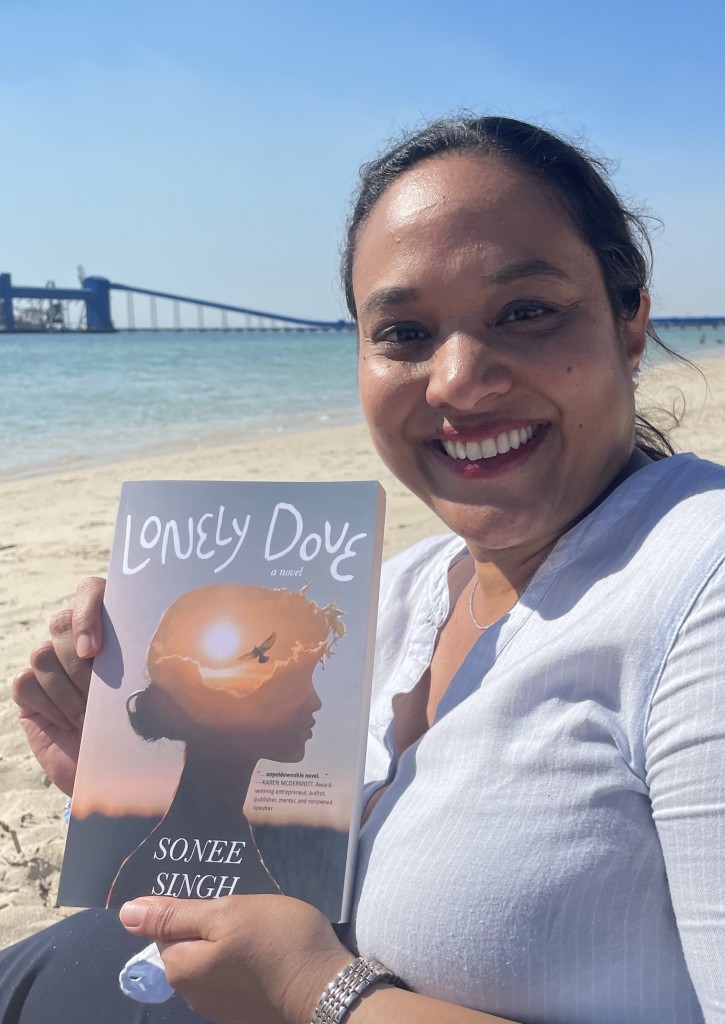
Welcome to my new series of interviews with guest authors! I hope you enjoy reading these as much as I enjoy talking with the guests.
Sonee Singh is a cross-cultural seeker of deep knowing. She writes stories of self-discovery to encourage people to accept themselves for who they are and live life on their own terms. Her tales are of her character’s definitive moments on their life’s journey. The mystical and spiritual are integral in her storytelling, as is her multi-cultural background. Sonee is of Indian descent, born in Mexico, raised in Colombia, and resides in the United States. When not traveling, reading, or writing, she indulges in meditation, yoga, and aromatherapy.
Sonee’s debut novel, Lonely Dove, was published recently by Koehler Books, and I spoke to her about the book and her journey as a writer.
Congratulations on the release of Lonely Dove, Sonee! You are a published writer of poetry, short fiction and non-fiction, but this is your debut novel, and it’s had some wonderful reviews. What drew you to tell this particular story?
Thank you! I had wanted to write a novel for a most of my life, but I didn’t have the courage to do it. After a serious illness in 2017, I finally decided it was time. When it comes to fiction, I am a pantser, which means that I start writing without knowing where the story will go. It’s not the same when I write non-fiction. I began one story, and eventually realized it wasn’t the one that was calling to me to complete. I started a second one and the same thing happened. At the beginning of 2018, I started a third one which turned out to be Lonely Dove, and when I started writing the story, I knew it was it—it would be my first novel. I used a love story and an obsession with finding a soulmate to showcase my protagonist’s journey of self-discovery and self-love. Having just awakened to my own journey of honoring myself (wanting to be a novelist), I felt this was the best story to start with.
The protagonist of Lonely Dove, Anji, has a cultural background similar to your own – she’s of Indian origin, grew up in Colombia and lives in the USA. What impact does Anji’s heritage have on her personal journey in this story?
Anji’s cultural background has a huge impact on her personal journey and it was a topic that came to her time and time again as she considered many aspects of her life, specifically, religion, food, what is appropriate or not when it comes to relationships, and what she needed to prioritize in her life (studies over dating), to name a few. There are many examples of this throughout the book. One is when she learned ethics while in school in Colombia. She had a hard time in the class because she realized that she didn’t kn0w more about Catholicism than about Hinduism, and this motivated her to learn more about Hinduism. As she grew up, and was exposed to more cultures, she considered herself less of a religious person and more of a spiritual person, and so when she set up her own apartment in New York City, her altar included deities and relics of various schools of thought. Culture also weighed heavily in her relationships, like what she felt comfortable discussing openly or not. When Anji viewed her search for a soulmate, she was torn between what she learned about dating in Colombia versus dating in America versus finding a partner in India.
Anji is a journalist, writing features for a magazine called Really Living. When she interviews Margarita for an article, her own path changes. Tell us a bit about Margarita and her significant role in Anji’s story.
Margarita is an intuitive healer. She was a medical doctor turned spiritualist and she earned a Doctor of Divinity degree. Margarita became Anji’s spiritual guide and teacher and helped Anji make sense of the visions she got. At first, the visions that Anji received were of her soulmate, but they evolved into something deeper. Margarita guided her in more visions, and she also helped Anji awaken her skills in the “clairs:” clairvoyance (seeing visions or clear seeing), clairsentience (getting feelings), claircognizance (deep knowing), and clairaudience (guidance through hearing). These were means and ways in which Anji learned how to listen to her intuition and connect with her inner guidance and with the universe.
I was struck by Anji’s openness to dreams and visions as life guidance. Do you think such abilities are genetic, or can anyone develop them in time?
I believe we all have them. Connecting with our intuition is something that we have innately. It is that “gut feeling” or “deep knowing” that we get about people, places, situations, or experiences. Children are particularly good at it. They instinctively know if they like someone or not. We all have it to begin with, and I believe that as we grow older we lose touch with our intuition, but if we dedicate ourselves to it, we can get it back and we can further develop our inner guidance. There are people who awaken to their intuition by sudden events, similar to Anji, where she got a vision seemingly out of nowhere. But we can also learn how to do this. We simply need to decide that we want to listen to our intuition, and once we do, it blossoms. This was my experience. I didn’t understand what it meant to have intuition, yet I heard so many people say that you don’t fail when you listen to it. At the time, I felt that I had been failing a lot, so I vowed that I would listen to my intuition. When I decided that I needed to connect with my inner guidance, I found the right resources and teachers, and since my intuition has been “reawakened,” it’s gotten stronger and stronger.
Lonely Dove is not easy to classify. There’s a romantic element to the story, as the protagonist searches for her ‘twin flame.’ But the heart of the book is Anji’s journey toward self-discovery – to reach this point she must heal from the wounds of the past and learn to accept herself as she is. This really resonated for me. Why is this theme important, especially for women?
We are all on a journey of self-discovery in one shape or another, although it takes different forms. We need to discover our self-love, our self-worth, our self-value, and it is not easy. Women, in particular, have a long history of being told that we are “less-than” or “not enough” in one way or another, and the more that we awaken to our value and our worth, the more empowered we get. The same applies to men, but women have been considered a “minority” even though we are not. However, when any person embarks on a journey of self-discovery it inevitably leads to self-acceptance, and this brings about healing—deep inner healing. The more people heal themselves, the more we extend that healing outside of us. Hurt people hurt others, and the more we love and value ourselves, the more we are able to extend that love and value to those around us.
What is the difference between a soulmate and a ”twin flame”?
I describe the topic in the book, but I don’t explain it completely because it is vast. To simplify, a soulmate is anyone who comes into our lives, romantic or not, who makes us feel seen and understood. Soulmates help us view ourselves and our lives in a deeper way. They can be a lover or partner, but also a parent, a friend, or a pet. Some are lifelong; some are temporary and come for small “lessons;” others are from previous lives; and there are even soulmates who do not bring about positive experiences. Sometimes impactful negative experiences are the result of soulmates who push us to expand or evolve in a way we need to but is difficult for us. Twin flames are a particular type of soulmate, and there is a lot of controversy about them, but in essence, twin flames are two souls who are deeply connected because they see or understand each other in a way that makes them feel that they belong or that they are “home.” Twin flames are often romantic, as I described in the book, but they don’t have to be. The twin flame connection is one that continues across lifetimes.
You move between past and present scenes in the novel. Present day is 2019, when Anji is forty-one and feeling uncertain about the future. As a younger woman she was convinced that finding her soulmate would be the key to happiness. Now she’s wondering if that was foolish and unrealistic. How did you choose which past scenes to include and where to put them in the present day narrative?
This was the result of a lot of rounds of edits and rewrites. The first time I wrote the novel, I wrote it as a letter from Anji to her soulmate where she started in the present day and flashed back to her childhood and then told her story in sequential order. In this way, I found it hard to portray how Anji evolved. I thought it would be more effective if she was able to relay how she made sense of the past as an adult, and that it would work better if she were able to go back and forth between the past and the present to show how she had grown and matured. This seemed more realistic because as we go through life, we don’t often understand what the past means until we are later in life, looking back. Then I felt that the letter narrative didn’t read well for a reader, so I rewrote the story in third person, as it is now. I felt it was easier to get a more objective view of Anji’s life in that way. I then mapped the relationships and the learning that Anji had from each, and reorganized them in a way that best showcased her evolution.
What have been the main differences between writing poetry and writing a novel?
Poetry is very different for me, not only because it portrays a snapshot or a moment, versus a novel that conveys an entire journey, but also because poetry is personal for me. I convey my thoughts, feelings, and perspectives. In writing a novel, I do that for my characters, and even though I can’t remove my influence, it isn’t me. Another big distinction is that I am only able to write poetry when I am inspired to do so. I haven’t been able to sit down and say to myself, “okay I’m going to write a poem.” I get a calling to write poetry at all times of the day and in all sorts of places and circumstances, and I capture them by pen on paper. When I edit them, I type them up, but the first version, I always write by hand. When I write novels, I dedicate specific time to it. I can and do decide I am going to write for a certain amount of time, and I sit in front of my laptop and write. I can’t do that with poetry. I also rarely write anything by hand for my novels.
I first met you at a writers’ retreat in Ireland, and we’ve since caught up a few times in Perth, Western Australia. I know you do a considerable amount of international travel. Does moving around make it difficult to write?
When we got out of the COVID lockdowns I decided to travel to find the city where I want to live, and that resulted in me spending a good part of the year on the road. I am looking for a place to live because I have moved around a lot in my life, and I finally feel the need to settle. I have continued to write during my travels. Nothing is as productive as having dedicated time in front of my laptop, but when I travel I make up for that by writing on airplanes and trains, as well as taking advantage of jet lag and writing when I wake up early in the morning or late at night when I can’t sleep. I don’t write as much when I travel, but I definitely write.
I salute your self-discipline! What are you working on now? Can we expect another novel in the future?
Yes, definitely! At the moment, it is NaNoWriMo or National Novel Writing Month. I had around 30,000 words of a novel at the start of the month, and my goal is to write 50,000 more words. It is a story about a woman who leads a safe, quiet, and relatively uneventful life until she receives a mysterious box. It changes everything for her. I also just submitted a fourth book of poetry to my publisher.
Last but not least, where can readers purchase a copy of Lonely Dove?
Purchasing links for Lonely Dove:
Amazon: https://www.amazon.com/gp/product/B0B6MLDSC5
Barnes & Noble: Lonely Dove by Sonee Singh, Paperback | Barnes & Noble® (barnesandnoble.com)
Apple: Lonely Dove on Apple Books
Bookshop: Lonely Dove a book by Sonee Singh (bookshop.org)
Photo credit: Karen McDermott



